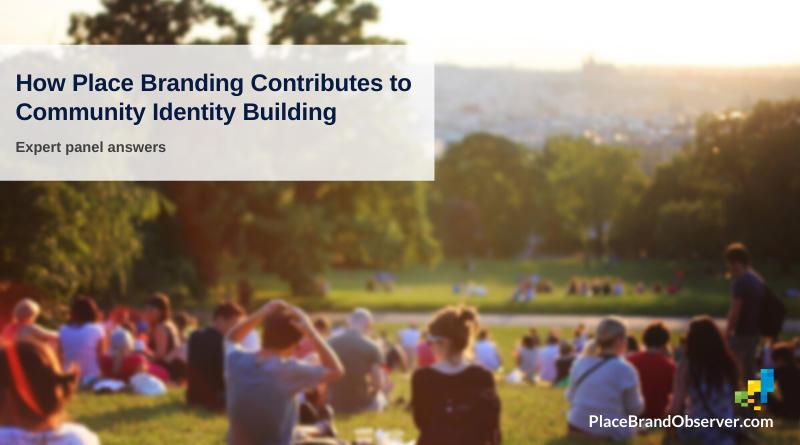What can bring society together in the aftermath of a conflict, and in a world where opinions are strong and divided? Can place branding be used as a means to reach common ground between people with opposing views and bring them together to take pride in a shared identity?
Read along to find the opinion of our panel of place branding specialists (in alphabetical order – highlighted respondents are available for consulting, research, or as speakers).
Our key takeaways:
- Place branding is in itself an activity that brings people together. It is about building a shared vision and identity, involving locals, which unifies societies.
- Though place branding can bring people together to form an identity, the will to act on a common vision solely lies with the people.
- In moments of upheaval or turmoil, place branding might not be a priority. But after the storm has passed, it is the perfect forum to mend estranged relationships, to rekindle and reshape the brand narrative together.
- Tourism is a great facilitator for implementing place branding initiatives, as it attracts less controversy and tends to benefit the local economy.
- In the current political climate around the world, place branding has the power to unite people from across the political spectrum, people from various religious, ethnic, and economic backgrounds.
Andrea Lucarelli
Place branding can be used to search for commonalities and common grounds, which may be found in the historic and cultural past of a place.
Anupam Yog
My current research in this area, yet to be published, explores the idea of place brands as “open systems”.
Companies, which have benefited enormously in terms of value creation and capture from branding, are closed systems. Nation, city, and place brands do not conform to the idea of closed systems. Well-conceived and thoughtfully constructed place brands can support the long-term stability of societies, which are “open systems”. However, they need to be inclusive and participative, developed from within the local, cultural, and social context: by the people, for the people, and of the people.
Caio Esteves
We need to reflect on what place branding is. For some, it is exclusively perception, external perception most of the time. For others, it is a bottom-up, inclusive, co-creative process involving a shared vision. I belong to the second group.
That said, it is clear that the place branding process, as it seeks a shared vision, deals essentially with conflict, and in that process tries to mitigate it by leading to an idea, or set of ideas, common to all involved.
It is in this case that we can contribute by facilitating the discussion about one’s own identity, something that is not part of everyday political discussions.
Ed Burghard
Brand identity is who you are, brand image is who others think you are. To the extent place branding focuses on educating the community on the facts about a location and consistently communicates the brand promise, it will help reduce misconceptions and focus residents on the benefits of living in that location.
Efe Sevin
- Place branding is identity building. It is all about making the lives of residents better. It is all about uniting them.
- If a place branding initiative does not serve the local population and does not unite them under certain ideas and ideals for the future, is it even a place branding campaign?
- ‘Branding’ might be one of the last tools in the minds of decision-makers during turmoil. Yet, place branding might be the best way to plan a future together with all relevant stakeholders.
Günter Soydanbay
Soydanbay Consulting / Speaker profile
Psychologists say that attention is the cardinal value of psychology. Along that line, change management experts state that the first step of change is creating awareness.
As C.G. Jung said, “One becomes enlightened by making the darkness conscious.” So, the place branding “process” could contribute to identity building and unity within a society by shedding light on societal issues.
We experienced something similar while working with the city of Bergama (Pergamon) in Turkey. Bergama is a destination that is on the UNESCO’s World Heritage List. One could say it is the Florence of Antiquity.
What makes the city unique and UNESCO-worthy is its multi-layered cultural landscape. It has been continuously habited for more than two millennia. All the Hellenistic, Roman, Byzantine, and Turkish periods and cultures are superimposed in Bergama.
The problem is that over the last two decades, the citizens of Bergama lost their bond of communion and ties of affection with the ancient Pergamon. They don’t feel they belong to that continuous multi-layered lineage.
While some political and religious factors contribute to the problem, the place branding process revealed that the root cause was actually economic. Due to the tourism policies of the Turkish State, the citizens of Bergama had been getting fewer and fewer revenues from tourism. So, over time, they stopped caring about the history and passing invaluable myths on to the next generations.
We built the place brand strategy on the above insights. We used the process to rekindle the lost connection between Pergamon and the people of Bergama, thus contributing to identity building within the society.
But there is a caveat. The place branding process can create awareness about societal issues. It can even help chart a course for building unity. But, I don’t think it can garner the desire to act. That to me is the natural limit of place branding.
Hjörtur Smárason
Scope Communications / Speaker profile
Identity is built on emotions like pride, and unity is built on shared goals and future visions. The role of place branding is to find a common ground to build on, and stories that build pride in the identity associated with the place, whether that is a city, a region or a country.
The base of any conflict is the creation of a divide. Creating a separation between ‘US’ and ‘THEM’. Each group believes a different story where the end goal of one group is based on the downfall of the other. A zero-sum game between colliding stories.
Place branding unites people within a certain place by developing a common ‘US’. To take pride in shared elements and shared stories, to see value in cooperation, and to see common interests in a shared future vision, despite any differences in past stories. A goal that can only be reached through cooperation.
In a way, you might say place branding is a team-building exercise including all the locals of a given place. A group of people with different backgrounds who all share a place, a society, and most importantly future goals. And they make that visible to anyone who visits, hence creating a common brand for their place, while simultaneously counteracting divides and tensions.
Jaume Marín
If you become part of a project and you feel part of it, you will create a brand that is loved. The best way to avoid any turmoil is to have all people involved from the very beginning, which also gives it more credibility.
Jeannette Hanna
Trajectory Brand Consultants / Speaker profile
This is a big topic. Let’s focus on one aspect – rebuilding a sense of identity when a place is facing the kind of turmoil generated by economic challenges and urban blight. Many cities face these challenges.
A place brand initiative can bring diverse stakeholders together to reimagine their collective aspirations and map out an inspiring, ambitious trajectory together. When Washington DC was facing bankruptcy in the 1990s, a group of committed urban activists took bold steps to reshape the city’s brand narrative. For first-hand accounts of their journey, listen to the Ikonicast episode here.
Juan Carlos Belloso
I believe place branding can, if well applied and managed, enhance the identification, self-esteem, and sense of belonging of citizens, and contribute to a common understanding about the place and a common vision for the future, shared values. By providing this shared vision and understanding of values and priorities for societies, it can help to stabilize them in turmoil.
Marta Hereźniak
Place branding as a process should be able to ignite a broad-scale debate of the values that a particular community is dedicated to uphold and to help determine how these values are to be interpreted.
From this perspective, if moderated with caution and sensitivity, place branding has the potential to bring communities back to their foundations and stimulate the sense of unity or – at least –initiate this long-term process in the new settings and (with the technological advancements) to democratize the discussion on how members of the community can regain their sense of belonging and stability.
Martin Boisen
For the love of place /Researcher profile
If the societies in question are currently going through a tumultuous period, maybe place branding shouldn’t be a top priority.
However, when place branding is already in place, and when it is aimed at unifying, increasing happiness, a sense of community, and positive pride – it can contribute to leveling out the most extreme parts of the turmoil that might come to occur.
Natasha Grand
Today, places are confronting a baffling problem. To have residents, people, life, it is no longer sufficient to have a source of employment: a factory, a port, a market. Moreover, it is not even enough to have a good public infrastructure: every other town, city, village, especially in North America and Europe, offers a very decent quality of life. Yet, people come and go. How many of you no longer live in your native town? How, then, do you keep and attract talent, inspire the curiosity of visitors, bring about big investors?
The answer is, exactly, by offering a meaning. Living in a place, visiting it, thinking about it – all of that must help people understand something about themselves, and to feel better about themselves. Or, at least, that they know themselves better. If you become a Londoner, you attach yourself to a way of life, a rhythm, a tradition. You start walking fast, and you do not talk to strangers, especially on the tube.
Place branding is now on the same cusp that commercial branding has gone through in the 1980s when businesses could no longer compete on the practical utility of their products and started imbuing them with a certain meaning, value, pointers to larger ideas and ways of life. This is where place branding is now.
The challenge for any place, whether it wants to become a global brand, like the city of Shenzhen in China is, or a small town that merely needs to keep going – is to provide a certain meaning. What does it tell about me if I live here? And this, in turn, requires of the existing residents to know: who are we? How do we live? What is important for us? What is the personality of our place that others can join in?
Interestingly, the people who have to resolve such questions for cities and regions, are not your usual suspects: they are not politicians or religious leaders, or ideological activists – those all operate at a larger scale. No, they are civil servants, usually from the culture or tourism departments of local administrations, or willing residents, also often known as ‘local madmen’. Their driving interest is usually not power nor money, but job responsibility and genuine love for their place.
As a result, place branding is the purest, non-political, non-religious, civic way to work out a collective meaning on a large scale. It unites people across political, economic, religious, ethnic divides in a natural, organic way. We all could do with that, especially now that political divides increasingly polarize.
Pärtel-Peeter Pere
Future Place Leadership
If, after the climate crisis, the second most alarming challenge today is inequality within communities, cities, within and between countries, then we need to focus on better including different groups of the society. It does sound like a tall order. However, it comes down to very practical and local things.
Branding – the work to create actual change at a place for the benefit of the local people and in view of the international reputational effect everything today has – can contribute to stronger communities.
For example, place branding is increasingly about placemaking, and place marketing is becoming more about design. If a city wants to be inclusive, green, or sustainable – everything rests on safety.
People need to feel safe in public spaces. Using, for example, feminist urban planning is a way to make cities safe and functional for women, thereby becoming safe and functional for all. Safer public spaces encourage interaction and as a consequence, a stronger sense of community.
Rebecca Smith
Place branding can help societies articulate their beliefs, values, and intent. Setting these out openly and overtly provides societies with a benchmark to hold themselves accountable to. It can provide the common language to enable citizens to call out actions, behaviours, or views that don’t gel.
A place brand can help unite citizens to a common cause to overcome challenges. But to do so, it needs to authentically and truly represent the views and beliefs of the majority.
Sebastian Zenker
Place branding can contribute to identity building by finding a common goal and stressing the similarities of the “we”.
However, place branding is not a magic potion that can heal every wound.
Tom Buncle
Yellow Railroad Consulting / Speaker profile
Creating a strong brand, into which residents and citizens have bought, not only provides a sound platform from which to build a global image, but it can also be a source of local pride. But it is essential that residents are involved from the outset in its creation. Presenting them with a fait accomplit is a recipe for rejection.
But a brand is not a substitute for substance. First, the issues causing turmoil have to be addressed, whether poverty, inequity, sectarian conflict, or civil war.
Once there is a basis for peace and moving forward, then – and only then – can a place brand begin to be developed, as part of the process of kick-starting the economy, largely through tourism (e.g. Bosnia-Herzegovina, Colombia, Rwanda).
Tourism, which requires a clear brand image as the basis for international marketing, can often provide the seeds of early, post-conflict, economic development, as it is relatively uncontroversial (unlike where to site a factory in a divided community). It requires limited investment compared to other sectors and delivers quick returns, as well as creating jobs throughout a country (rather than just in the capital).
Get to know the panel here.
You’d like to ask the panel a question? Get in touch!
Enjoyed this collection of expert views on how place branding can help societies in turmoil by instilling pride in people and creating a sense of belonging? Thanks for sharing!














